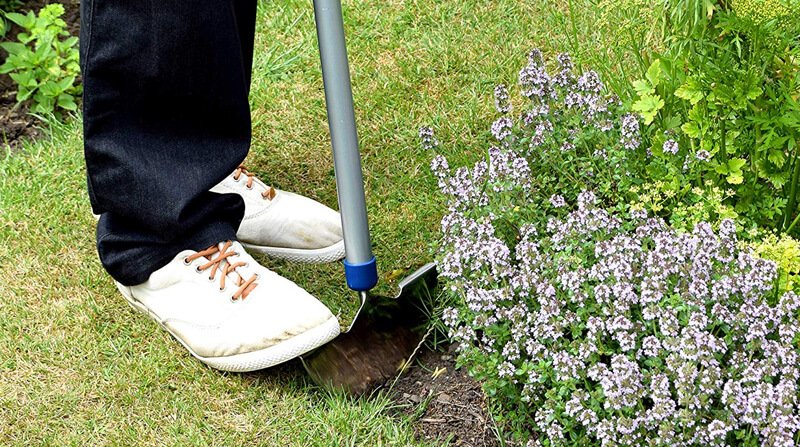Nothing ruins the look of a well-manicured lawn like untidy edges.
However, get it right and you’ll create a fantastic finish.
So, in this article, I’ll show you how to edge a lawn like a pro. From cutting new edges to maintaining them after mowing.
Two Different Types of Lawn Edges
Before we get started, it’s important to understand there are two different types of lawn edge;
-
-
- Open edges – these are edges of your lawn which are exposed. Along planted borders for example.
- Closed edges – are where the edge of the lawn meets another surface. A path, a lawn edging product, mowing strip or driveway.
-
You’ll treat each type of edge slightly differently so we’ll look at caring for them individually.
How to Edge a Lawn With Open Edges

Creating and maintaining open edges is fairly easy and you can use a range of tools to do it.
Step 1: Mark Out the Edge You Want to Cut
For straight edges, it’s best to use a long plank of wood as your guide.
I personally have an ‘edging plank’ which has long nails hammered through it. That way, I can push it into the lawn and be confident that it won’t move.
Alternatively, you can stand on the plank to keep it in place.
If you’re creating curved or wavy edges, use a warm hosepipe or piece of rope and secure it in place with some U shaped garden pegs, like these ones on Amazon.
Alternatively, if you’re neatening up an existing edge, you can use the current edge as your guide.
Step 2: Cut the Edges
There are a couple of tools you can use to cut new edges.
- A half-moon edging iron, or
- A powered edge cutter
I find a half-moon cutter is best for cutting straight edges. The top edge of the blades is treaded so you can push into the turf using the weight of your foot. It also acts as a depth indicator so you can cut the edges to a consistent depth.
However, a half-moon edger isn’t great at cutting wavy edges.
A powered edge cutter works best for me. You simply walk behind and guide it while a spinning blade cuts the edge. The fact that they have wheels makes it very easy to cut curved edges.
Step 3: Remove the Cut Turf
With the new edges cut, you’ll want to remove the excess turf.
This will create a well-defined edge.
Step 4: Protect the Edge
I like to protect my lawn edges from damage and/or the weather.
A simple way to do this is to pack some soil up against the edge of the lawn and create a slope of around 20 degrees into the border.
This will prevent the edges of the lawn drying out and turning brown when the weather gets hot.
Another way to protect the edges is to install a lawn edging product like Fexi-Border or Everedge. Doing this prevents the edges of your lawn from eroding away or damage so you won’t have to keep re-cutting them.
Step 5: Trim the Edges After Mowing
Trim the grass at the edge of your lawn every two or three cuts with the mower to keep the grass from overhanging into the borders and looking untidy.
My advice is to use a pair of edging shears. However, some of the best grass strimmers have heads which swivel so you can strim the edges.
That said, creating neat edges with a strimmer takes a fair amount of practice.
How to Maintain Closed Edges

In many ways, maintaining closed edges is easier than open edges because the edge of the lawn is defined by the path, wall or fence which it meets.
Paths and Driveways
If your lawn meets a path or driveway, then chances are, you’ll be able to roll your lawn mower right over it and use it as a mowing strip.
However, lawns can easily grow over the edges of a path, creating an undefined, messy edge.
To keep the edges well defined, I like to use a powered lawn edger like in the image above.
You can also a half-moon edging iron but it can take time.
Walls and Fences
If your lawn meets a wall or a fence then even the best lawn mowers will fail to cut right up to the edge.
In this case, the only option is to use a strimmer.
The Danger of Closed Lawn Edges
More often than not, closed lawn edges are either paths, driveway, fences or walls.
During the summer, they can get very hot during the day and they hold onto that heat even when the temperature cools down at night.
This cause the soil and the grass at the edges of the lawn to dry out and turn brown.
So if your lawn meets a path, driveway, fence or wall, make sure you keep the edges well-watered during the summer.
Another way to tackle the problem is to install an edging product.
In Conclusion
As I said right at the beginning of this article, nothing ruins the look of a lawn like untidy edges.
By learning how to edge a lawn properly, you’ll always be able to create that ‘finished’ look to your lawn.
Not only that, but defined edges create a sense of order to your garden, clearly separating different areas and creating recognisable shapes.
It’s an incredibly easy way of giving your lawn a facelift.

